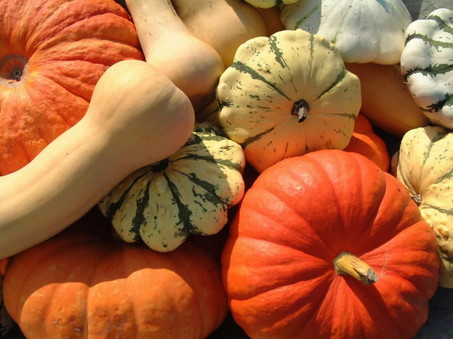Growing Winter Squashes
Pumpkins and winter squashes are now starting to ripen, and if you’ve been eyeing them up in a neighbour’s garden or allotment, you may have decided that you want to grow some next year. But what do you need to do? This little guide will help you prepare for next year.
 1) Choose your variety
1) Choose your variety
You can buy squash plants at garden centres in spring, but you don’t get much choice. A better option is to buy seeds, because you can choose from a much wider range of varieties. Think about whether you want big Halloween-style pumpkins, or smaller squashes, and whether the precise colour is important. There are a wide range of pumpkins and winter squashes such as butternut squash, so do check out both categories in the seed catalogues or racks.
Also think about where you want to plant them. They are quite big plants, so will need space. You can grow them in containers, if you tie them into a tripod to keep them climbing not scrambling over your patio, but bigger varieties will be happier in the ground.
2) Sow Early
Your seed packet will tell you when you can sow seeds under cover. If you’re growing several varieties, three or four seeds of each will give you plenty of plants, which you can give away to friends, because you only really want one or two plants of each type. Sow in small individual pots, using seed compost, which you can buy from compost suppliers or garden centres.
Pumpkins need warmth and moisture to germinate, so put the pots into a propagator, or cover with plastic bags. Keep them in a sunny spot, such as on a greenhouse shelf, or warm windowsill. Keep an eye on them, and open the propagator during sunny days once germinated. But be careful, as they can be quite cold-sensitive, so you’ll need to coddle them a bit at night.
3) Pot on
If your plants look like they’re outgrowing their pots, then you’ll need to pot them on. Whether you plan to grow them in containers, raised beds or in the vegetable patch, you won’t be able to plant them outdoors until all risk of frost is over. So keep moving them into bigger pots to give them enough space to grow until you’re ready to plant outside. If you’re planning to grow them in containers, you can move them to the final container earlier, but keep it under cover.
4) Water and feed
Especially in containers, but also in garden beds, your pumpkins will need feeding and watering regularly, but will otherwise grow without fuss in any sunny spot, and produce squashes happily for you. Next year, you could be carving your very own home-grown Halloween pumpkin!
 1) Choose your variety
1) Choose your variety